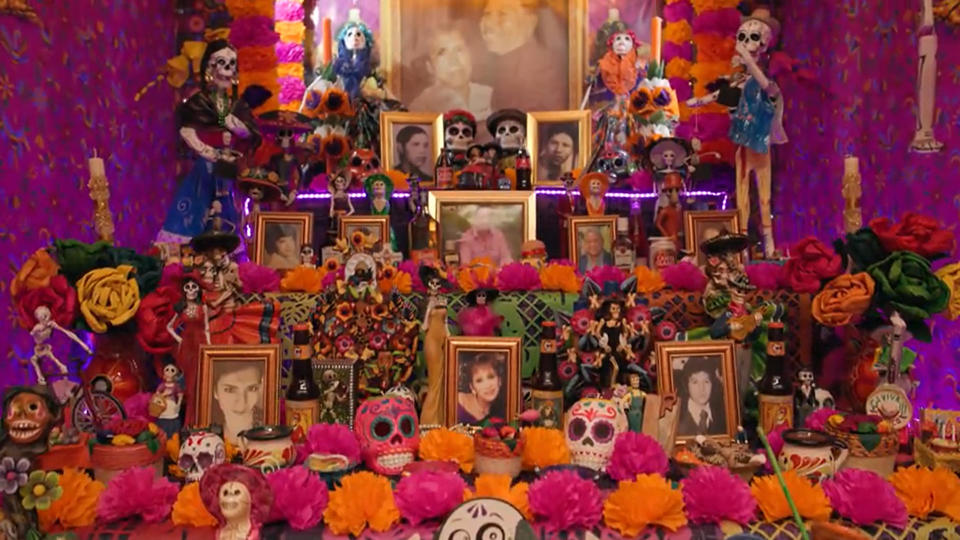Stories behind Day of the Dead

Like clockwork each autumn, Mexico City's floating gardens and bustling markets explode in a fiery display of orange. The cempasúchil flower (known in the U.S. as the marigold) is seemingly everywhere, its pungent smell said to guide departed souls back for what's become Mexico's largest public celebration: Día de los Muertos, or Day of the Dead.
"I believe the Day of the Dead is the most beautiful tradition of Mexico," said Elena Reygadas, one of Mexico's most renowned chefs. This time of year she's busy making pan de muerto, or "bread of the dead." A traditional sweet bread, pan de muerto is often left on the elaborate offrendas (or altars) built to honor deceased loved ones.
It's said that no one is really dead as long as they aren't forgotten.

Day of the Dead recipe: Pan de muerto by Elena Reygadas
Practiced for centuries in many parts of Latin America, Day of the Dead is a fusion of Roman Catholic and Indigenous rituals. Author Regina Marchi said, "When the Spanish arrived, they actually tried to eliminate what they considered to be pagan alter-making traditions of the Indigenous people, but they really couldn't wipe those out because they were so strongly a part of people's culture. So, eventually they required the Indigenous peoples to move those rituals to November 1, which is All Saints' Day, and November 2, which is All Souls' Day."

Marchi documented the holiday's growing popularity on both sides of the border in her book, "Day of the Dead in the U.S.A." "Day of the Dead, as we know it today, is a relatively modern creation," she said. "Yes, Indigenous peoples in Mexico and in Mesoamerica have always had a profound respect and love for their ancestors. But street processions and dressing like skeletons and face painting, it's really in the past 50 years you've seen that development."

And while some mark the occasion by dressing up, Día de los Muertos isn't Mexican Halloween.
Claudia Curiel de Icaza, Mexico City's culture minister, said this weekend's official parade is a showcase for Indigenous groups to present their interpretations of Día de los Muertos. Millions usually attend, many coming from around the world.
Acevedo said, "It always surprises me how we bring the celebration to everything that we do, even remembering our dead."
"It's part of the cycle of life, death, for us," said Icaza. "So that's why we celebrate it."

And since Disney's Academy Award-winning 2017 film "Coco," the holiday is more popular than ever, especially in the United States, where there are more than 37 million Americans of Mexican descent. Now, you can decorate your offrenda at Target, and buy your pan de muerto at Costco.
Reygadas doesn't think that takes away from the holiday tradition: "I believe the beautiful thing is that it's alive," she said.
Marchi says what makes Día de los Muertos so appealing is a universal desire to connect with those we've lost, and with each other: "Many people feel like there isn't a time or a place where you can publicly celebrate the lives of those people that meant so much to you, that help shape who you are, who you still love, even though they're no longer physically with us. So, this wonderful holiday is a real gift from the people of Mexico."

For more info:
"Day of the Dead in the U.S.A.: The Migration and Transformation of a Cultural Phenomenon" (2nd edition) by Regina M. Marchi (Rutgers University Press), in Hardcover, Trade Paperback and eBook formats, available via Amazon, Barnes & Noble and Bookshop.orgChef Elena Reygadas (Instagram)
Story produced by Mark Hudspeth. Editor: Emanuele Secci.
How a New England lobster shack became one of the top seafood spots in the country
Israeli forces tighten their grip on Gaza City
Oksana Markarova, Ukrainian ambassador to the U.S., says "war on terror has to be won everywhere"

